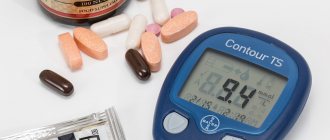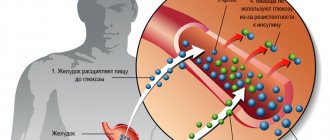Glycated or glycosylated hemoglobin is a component of total human hemoglobin, which circulates through the blood and is bound to glucose. The indicators of this analysis are determined as percentages. The more sugar there is in the blood, the higher the percentage, and the hemoglobin becomes glycated.
This is an effective and informative type of examination that allows you to monitor the course of diabetes mellitus or make a diagnosis if the disease is suspected. The test is highly accurate and provides information about the average glucose level over the past few months.
The norms of glycated hemoglobin for diabetes mellitus are universal, that is, suitable for adults and children.
What is glycated hemoglobin?
HbA1C: what is it? Glycated hemoglobin is a protein that has established a bond with glucose. Hemoglobin is part of red blood cells and is a protein structure.
The life cycle of red blood cells takes no more than 3 months. Therefore, an analysis of glycated hemoglobin gives an idea of the amount of glucose in the blood over a period of 3-4 months. Completing the test allows you to suspect diabetes mellitus in time and monitor your sugar levels if the disease has already been diagnosed.
Attention! The method does not reflect changes in the amount of sugar in the bloodstream after eating.
The analysis result may be distorted for several reasons:
- The study was carried out immediately after blood transfusion or bleeding.
- Testing in different laboratories that use different methods for determining glycated hemoglobin.
Source: https://ru.wikipedia.org/wiki/Glycated_hemoglobin
PRODUCTS FOR DAILY NUTRITION: DIET IN PRACTICE
The doctor, selecting foods that are useful for low hemoglobin, adjusts the diet individually. Compliance with the optimal amount of consumption minimizes the risk of possible allergies and imbalances in microelements entering the body.
- Beef can replenish one fifth of the body's daily requirement for iron. In second place is the liver .
- An excellent remedy is red caviar. But keep in mind that it is high in calories.
- The diet includes a variety of plant foods : beets, carrots, rowan berries, pomegranates, nuts, carrots, raspberries, blackberries, strawberries, blueberries, black currants, grapes, peaches, bananas, dates, garlic. Citrus fruits are allowed only to those people who do not have allergies.
- An affordable remedy included in the diet to normalize hemoglobin levels is rosehip decoction . Drink it 250 ml per day. To prepare the decoction overnight, pour 20–30 g of berries with boiling water.
- Among nuts, walnuts contain the most iron. Every day you can eat 100 g of nuts mixed with honey.
- honey itself is enough every day. This product not only provides the body with iron, but also has a general strengthening effect.
- Red grape wine is drunk little by little.
- Legumes and grains are rich in iron, but at the same time they contain substances that impair the absorption of the element. To neutralize them, the grains need to be soaked, ground or sprouted.
- Dried fruits are a very tasty remedy. Mix raisins, dried apricots, prunes and walnuts in equal proportions. The mixture is passed through a meat grinder and coated with honey. Eat 120 g daily. The presence of copper, pyridoxine hydrochloride, ascorbic and folic acid in the products promotes the absorption of iron to maintain hemoglobin balance in the blood. Therefore, diets often include tomato, orange and grapefruit juices, parsley and other greens.
Another aspect of dietary adjustment is to limit the consumption of foods that impair iron absorption - coffee, tea, cheese, pasta, cereals (the exceptions are buckwheat and oatmeal).
Diabetes mellitus and glycated hemoglobin
Glycated hemoglobin in type 2 diabetes has different values, which are directly dependent on the age of the patient:
| Age category | Diabetes without complications (mmol) | Diabetes with complications (mmol) |
| Middle aged people | Sugar is 8.6 | 9.4 |
| Elderly patients | The amount of glucose reaches 9.4 | Sugar level rises to 10.2 |
Blood for diagnosis is obtained from a finger. If the amount of sugar in an elderly diabetic drops to 7 mmol/l, then this may result in hypoglycemia for him.
HOW TO ADD TASTE TO YOUR DIET
Often there is not enough iron in food, especially for vegetarians. Adjustment of the diet aimed at the synthesis of hemoglobin and red blood cells - the formed elements of blood - is enhanced by taking special medications. Iron-rich hematogen lozenges can be used as a tasty aid, as well as additional prevention. “FERROGEMATOGEN®-PHARMSTANDARD” has been developed for adults, and “FERROGEMATOGEN® CHILDREN” has been developed for children of different ages.
The drugs belong to dietary supplements and serve as additional sources of iron. They contain black food albumin, proteins, iron, copper and vitamins (pyridoxine hydrochloride, ascorbic and folic acid) in optimal proportions.
Adults and children over 11 years of age can take FERROHEMATOGEN®-PHARMSTANDARD 50 g per day. Children 3–7 years old are given 30 g of FERROHEMATOGEN® CHILDREN, and 7–11 year old children – 40 g. Duration of administration is 1–2 months.
Hematogen is contraindicated in case of individual intolerance and diabetes mellitus. Before use, consult a doctor.
"Pros" and "cons" of analysis for glycated hemoglobin
Like any diagnostic test, analysis to determine the amount of hemoglobin has its advantages and disadvantages. The first ones include:
- The method is carried out without regard to the time of day. Food intake also does not distort the study results.
- The analysis allows you to detect diabetes in the early stages of its development.
- The procedure takes minimal time and costs.
- The patient is not required to undergo special or lengthy preparation before donating biological material.
- The psychological background (stress, emotional overstrain) does not affect the accuracy of the final results.
- You are allowed to take medications before the study.
Article on the topic:
What is insulin resistance? Symptoms, treatment and diet
The information content of the analysis is a big plus. However, the study also has important “disadvantages”, of which it is worth noting:
- Its high cost. Other types of research cost much less.
- The results are not always true. If a patient is anemic, it can give doctors a false picture of the patient's condition.
- The exclusivity of the research. Not every laboratory conducts this analysis.
- Distortion of results due to hormonal imbalances. This happens when the thyroid gland does not produce enough hormones.
Attention! To ensure that doctors and patients receive the most accurate results, repeat tests must be taken in the same laboratory where the first test was performed.
Treatment of anemia in diabetics
90% of patients with second-degree diabetes develop anemia, which worsens the quality of life. A lack of red blood cells and low hemoglobin have an impact on the quality of the patient’s sexual, physical and mental-intellectual activity.
Anemia is treatable. This does not apply to patients with renal failure, which is not treated with mineral and vitamin complexes; without proper medical supervision, it goes into a severe stage and can lead to disability. In cases where anemia develops due to a lack of the hormone erythropoietin in the body, it is treated with the complex use of medications containing this hormone. Erythropoietin is prescribed by the attending physician if there is no effect after using other drugs containing iron. However, most doctors are inclined to start treatment with erythropoietin immediately, believing that this will prevent the destruction of the walls of small vessels in the patient and prevent the development of nephropathy (kidney damage).
Erythropoietin is administered either intravenously or subcutaneously. The second method allows patients not to seek the help of a doctor, but to carry out injections on their own. The hormone is administered three times a week. To increase the effectiveness of treatment, doctors recommend combining hormone injections with the use of medications containing iron.
What is the norm for glycated hemoglobin?
Indicators of glycated hemoglobin in people who do not have diabetes range from 4 to 6.5%. The norms of the protein-containing component for healthy women are given below:
| Number of years | Target level (%) |
| Up to 30 | Within 4-5 |
| From 30 to 50 | From 5 to 7 |
| Starting at 50 | Not less than 7 |
A sharp upward rise in the target levels of glycated hemoglobin indicates the onset of diabetes mellitus. This outcome of the study is a reason to contact doctors for appropriate treatment.
A1C indicators in healthy men also depend on age category. The norms for representatives of the stronger sex are indicated in the table:
| Number of years | Normal values (%) |
| Up to 30 | From 4.5 to 5.5 |
| From 30 to 50 | From 5.5 to 6.5 |
| From 50 | Around 7 |
Particular attention should be paid to sugar levels in men and women after reaching 40 years of age. It is also necessary to monitor these indicators if there are signs of obesity.
Top 10 in the product list
- Carrot. And the best thing is freshly squeezed juice from this root vegetable. To increase hemoglobin, just get into the habit of drinking 4 glasses of juice on an empty stomach for a week. At the same time, it is best to add fat to the glass of carrot juice - for example, cream.
- We recommend using unroasted buckwheat. It is best to pour boiling water over buckwheat in the evening and consume it in this form in the morning.
- Dried fruits contain more iron than other types of fruits.
- Raspberries contain the greatest amount of iron.
- Liver, mainly beef or pork. It is these products that are recommended to be included in the diet of expectant mothers first. In addition, compared to plant foods, iron from animal foods is absorbed by the body in greater quantities.
- The next important product for increasing hemoglobin and maintaining it at a normal level is seafood. We advise you to indulge in mussels and shrimp. For people with good incomes, oysters and cuttlefish will be useful.
- Nuts and pumpkin seeds are rich in such a valuable element as iron.
- Lamb and beef are not only rich in iron, but will also prevent you from gaining excess cholesterol.
- It is very useful to drink a drink made from honey and rose hips. For greater effect, brew rose hips in a thermos. Don’t forget to add a teaspoon of liquid honey to the finished drink. If you only have candied sugar in the house, just melt a small amount in a water bath.
- For people who do not suffer from problems with the gastrointestinal tract, we recommend eating plums in large quantities. It has been proven that regular consumption of plums will improve hemoglobin levels in a few months, and this without any drugs.
Based on products useful for increasing hemoglobin in women and men, special recipes are used in folk medicine. We will introduce you to healthy mixtures of products .
Raising hemoglobin is extremely important for overall health
» data-medium-file=»https://i2.wp.com/saharny-diabet.ru/wp-content/uploads/2015/01/kak-podnjat-gemoglobin.jpg?fit=300%2C230″ data- large-file=”https://i2.wp.com/saharny-diabet.ru/wp-content/uploads/2015/01/kak-podnjat-gemoglobin.jpg?fit=375%2C288″ title=”Hemoglobin” alt=”how to increase hemoglobin” w >
It is very useful for people with low hemoglobin levels to consume this mixture every day: you need to take one spoonful of all the ingredients - cranberries, honey and crushed walnuts.
Pregnancy and glycated hemoglobin
The results of analysis for glycated hemoglobin in a pregnant woman and just a woman are different. In a pregnant woman without pathological abnormalities, the amount of glycated hemoglobin does not exceed 6.5%. A woman who is pregnant and has diabetes needs to undergo testing once every 2 months. This measure is required in order to respond in time to a jump in hemoglobin and provide medical assistance.
Interpretation of laboratory data must be carried out taking into account the fact that pregnant women are often diagnosed with anemia, vomiting, and weakness. All these factors affect hemoglobin levels. The interpretation of the numbers after the analysis is as follows:
| Results (%) | Data decryption |
| Less than 5.7 | Metabolism is normal. The likelihood of diabetes mellitus is minimal. |
| From 5.7 to 6 | The chances of developing diabetes are great. Pregnant women are advised to reduce their intake of carbohydrate foods. |
| From 6.1 to 6.4 | The most suitable conditions for the onset of diabetes. Preventive measures: diet with a minimum of carbohydrates. |
| More than 6.5 | The intermediate diagnosis is diabetes mellitus. It is clarified with the help of other diagnostic studies. |
Article on the topic:
What is polyneuropathy of the upper and lower extremities? Symptoms, diagnosis and treatment
Poorly functioning excretory system (renal apparatus). However, when donating blood for glycated hemoglobin, you can not always count on obtaining true results. The latter is directly related to the restructuring of the female body during pregnancy. If hemoglobin levels are always far from normal, then the reason for this may be:
- Damage to blood vessels.
- Ophthalmological problems.
- Excessive fetal weight.
At the end of the 3rd trimester, the analysis is no longer carried out, since at this stage it is no longer possible to obtain reliable data.
Diagnostics
Anemia is a complex disease, and in order to study it sufficiently and identify the true cause, diabetics need to undergo a special examination. Low hemoglobin is determined using a general blood test, but the reasons why it is low vary. Often, high sugar provokes kidney disease, leading to anemia. Therefore, the following studies may be required as part of the diagnosis:
- Hba1C level. Glycosylated hemoglobin indicates the presence, severity or predisposition to diabetes, and also indicates the level of risk of complications. The target is 7%. A diabetic needs to take this test 4 times a year.
- General urine analysis. Indicates a malfunction in the functioning of a paired organ.
- Ultrasound of the kidneys. Detects the presence of organic damage to the renal parenchyma, characteristic of diabetes.
- Erythropoietin concentration. Indicates the nature of anemia. A normal level of this hormone with low hemoglobin indicates iron deficiency anemia. If there is too little of this substance in the blood, we are talking about serious kidney damage. Further treatment depends on the results of this study.
Anemia in diabetes increases the risk of developing cardiovascular diseases.
Low or high glycated hemoglobin: what to expect?
An increased or decreased content of glycated hemoglobin provokes disorders in organs and systems. Complications include:
- Vessels. Their lumen gradually becomes narrower and narrower, and the walls themselves lose their former elasticity, becoming fragile. These modifications prevent the flow of oxygen in the same volume. Over time, this leads to heart attacks and strokes.
- Kidneys. Pathological changes in the kidneys lead to renal failure.
- Skin. Any, even extremely minor, damage to the skin takes a long time to heal. The regeneration process is hampered by the addition of an infectious agent.
- CNS. Sensitivity in the arms and legs decreases. Patients complain of a feeling of heaviness or weakness in the limbs.
Symptoms
The symptoms of anemia in different pathologies are similar, but they will be more pronounced in diseases that inhibit the formation of hemoglobin protein.
Low hemoglobin is manifested by the following symptoms:
- the appearance of dizziness;
- the skin becomes paler;
- presence of chronic fatigue;
- feeling of weakness in the muscles;
- sleep disturbance;
- development of intolerance to cold;
- the appearance of shortness of breath;
- cheilitis;
- disruptions in the cardiovascular system.
Diagnostic measures
There are now a large number of ways to detect the level of glycated hemoglobin:
- Electrophoresis.
- Liquid or affinity chromatography.
- Immunological methods.
- Column methods.
When selecting a suitable laboratory analysis to determine the concentration of glycated hemoglobin, preference is given to analyzers with a reference method, which is usually liquid chromatography.
It is important! The use of standard examination methods allows laboratories to obtain results that are comparable to the data obtained from the organization of reference methods. All this significantly increases the reliability of the results obtained.
It is very important that the specialist uses the diagnostic results obtained in his work, but only from those laboratories whose activities are officially certified.











